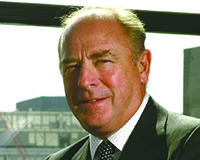 We hear a lot about how the arrival of Crossrail, HS2 and the extension of the Northern Line will open up locations adjacent to the core London market and further beyond, and make central London smaller in many ways.
We hear a lot about how the arrival of Crossrail, HS2 and the extension of the Northern Line will open up locations adjacent to the core London market and further beyond, and make central London smaller in many ways.
In the context of residential markets, these infrastructure and transport improvements will certainly open up locations which were not previously viable for some commuters. There are now real possibilities for homeowners to buy further away and travel to work in reasonable time.
But is the same true about occupiers moving further outside of central London? I think the story for commercial property is different.
For office occupiers it is increasingly all about where they can best recruit and retain talent. The office environment needs to offer good quality and good value space. It needs to be exciting, architecturally interesting and promote wellbeing, with good amenities, vibrancy and, of course, have good transport connections. Crossrail will be fundamental in this regard.
Decisions are being made which are no longer about chief executives and chairmen preferring certain locations. They are choosing space where the workforce is happy. People are working longer hours. They need street life and restaurants. They want flexible space where they can be near to their colleagues, clients and friends. They want to “huddle”. It must have good communications.
People are spending most of their lives working and socialising and the two are becoming more intrinsically linked as time goes on. We have seen fintech companies move back to the City fringes to be closer to clients, we saw Amazon’s recent move to Principal Place, EC1, from Slough, where it had been located since the 1990s.
Of course, it is also about price and we continue to see a flight to value.
Look at Fitzrovia in the West End, this area has previously been the poor relation to Mayfair. Agents for some time called the area east of Oxford Circus “the Far East”. CBRE now forecasts Fitzrovia to be the best performing area in London in the next few years, and we agree. It is an area already showing rapid change and attracting top quality tenants.
Similarly, in the City fringe to the east, we continue to see huge opportunities in the Tech Belt and Whitechapel, and also in Paddington. I think we will see retail and leisure offerings further improve, with exciting operators wanting to be in these traditional office locations.
We have let 500,000 sq ft this year. We have never had a market where there has been such strong, good quality demand. What is particularly interesting is that people are looking two to three years ahead. Much of the recent take-up is preletting activity on sites under construction, across a range of sectors, from financial to creative industries.
At White Collar Factory, EC1, in the heart of the Tech Belt, we have prelet six floors ahead of completion in 2016, with some of this space being let to business services. Occupiers are becoming organised earlier, and the trend towards preletting is expected to continue into 2017 and 2018, with some enquiries coming in already for occupation in 2019/2020.
There continues to be lots of discussion about oversupply. Supply is low. Central London vacancy rates are still under 3%. Market dynamics are strong, particularly in the West End. CBRE estimates 70% of London’s commercial property development is in the City core, based on a number of large projects.
It is a very different market to the areas in which we operate – largely in the West End and the Tech Belt, where development is smaller in scale and supply remains muted. We are speculatively progressing our projects at 80 Charlotte Street and 1 Oxford Street in Fitzrovia, W1, and at the Brunel Building in Paddington, W2. These are three substantial and exciting schemes.
Central London is a global city which offers diversity, an unrivalled talent pool, excellent infrastructure and transport links. Most importantly, it should continue to offer good value and good quality office space to meet the changing needs of the business occupier.
John Burns is chief executive of Derwent London










